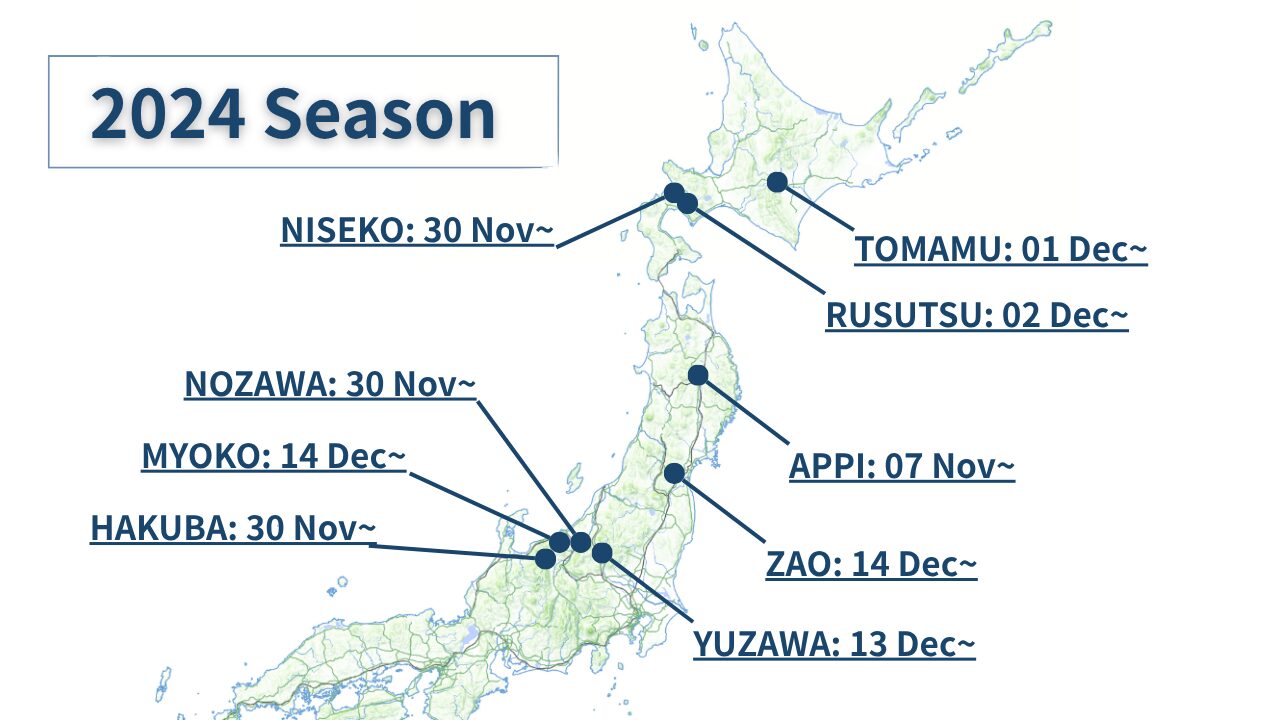1. Overall climate & snow trend for November
November is the transition from autumn to winter across Japan. Daytime temperatures are relatively mild while nights and mornings become noticeably colder, and mountain areas may begin to see early snow. Because overall temperatures and snowfall are not yet reliably low or abundant in November, the chance of finding true JAPOW (deep, light powder) is low. Nevertheless, for those eager to get on the snow early, the outlook is not unfavorable.
Japan’s Sea of Japan mountain ranges and northern regions have increased expectations for early openings. For example, some well-known resorts in Hokkaido are considered possible candidates for skiable conditions from the end of November. The Japan Meteorological Agency’s one-month outlook describes winter precipitation and cold air patterns as showing some La Niña-like signals but without a decisive El Niño/La Niña bias — overall close to or slightly above average snowfall is possible. With that context, we review region-by-region points for November below.
2. Nagano Prefecture
Forecast & tendencies
Nagano, home to the Japanese Alps, is one of Japan’s premier ski & snowboard areas. From November, high-elevation resorts (for example, Hakuba Valley and Shiga Kogen) will experience colder mornings and nights, and initial snowfalls may occur in late November. However, sufficient snow depth for widespread, reliable skiing typically develops in December, so November is usually a preparation period for openings.
Because daytime temperatures in November can be comparatively mild and prone to melting, even when snow falls coverage may be thin and resorts may open only limited terrain. Mid- to low-elevation fields commonly rely on snowmaking. Resorts around 600–1,000 m elevation may face a tougher start in both quantity and quality of snow.
Notable opening info: Hakuba Valley has announced a scheduled opening on December 1.
Japan Meteorological Agency (JMA) one-month notes
- Because warm air masses are likely to dominate at times, average temperatures over the next month are expected to be higher than usual.
- Low-pressure systems and fronts may affect the region at times, so precipitation over the next month is expected to be above normal and sunshine durations below normal.
3. Niigata Prefecture
Forecast & tendencies
Facing the Sea of Japan, Niigata is a classic “snow country.” When winter pressure patterns strengthen, moist air off the Sea of Japan hits the mountains and produces heavy snowfall, so early snow is more likely here than in many inland areas. Still, early November can retain autumnal conditions (clear, dry days), and there is no guarantee of rapid accumulation or stable skiable coverage. Low-elevation and inland spots are at higher risk of rain or sleet rather than snow. The key is increased cold spells and more frequent cold air intrusions toward late November.
Notable opening info: Akakura Onsen Ski Area has announced a scheduled opening on December 13.
JMA one-month notes
- Average temperatures over the next month are expected to be higher than usual due to relatively warm air masses.
- Precipitation over the next month is expected to be near or above normal because the region can be affected by low-pressure systems and fronts.
4. Tōhoku Region
Forecast & tendencies
Tōhoku (for example, Yamagata, Miyagi, Iwate) tends to receive heavy snowfall and excellent snow quality once winter is established, but in November it generally takes longer for sufficient accumulations to appear. Lowland and lower-elevation areas often still see rain or mixed precipitation. High-elevation resorts such as Appi Kogen and others may reach opening condition by late November into early December, depending on cold snaps and snowfall frequency.
Notable opening info: Appi Kogen Ski Area has announced a scheduled opening on December 6.
JMA one-month notes
- Average temperatures in the coming month are expected to be higher than usual due to warm air masses.
- Precipitation: the Sea-of-Japan side of Tōhoku is likely to see near or above normal precipitation; the Pacific side likely sees above normal precipitation.
5. Hokkaido
Forecast & tendencies
Hokkaido often leads Japan in opening the ski season. If northwesterly winds and cold air align with moisture from the Sea of Japan, some resorts can be skiable as early as late November. There have been reports suggesting above-average snowfall potential for the 2025–26 season in some Japan Sea coastal zones of Hokkaido. Still, dependable skiing requires the right combination of elevation, exposure, and sustained cold — lowland or inland areas may remain insufficiently snow covered in November.
Notable opening info: Niseko and Rusutsu have announced scheduled openings on November 29.
JMA one-month notes
- Temperatures: because warm air may dominate at times, temperatures on Hokkaido’s Japan Sea and Okhotsk coasts are expected to be near or above normal; Pacific coast areas are expected to be higher than normal.
- Precipitation: Japan Sea coast of Hokkaido may see near to above normal precipitation; Okhotsk and Pacific coast sectors may see above normal precipitation.
- Daylight: Japan Sea coastal areas may receive near or slightly above normal sunshine in part because some cold-air patterns are less frequent there in the short term.
6. Opening days last season

7. Summary
November is the “Early Bird Season” for skiing and snowboarding in Japan. It is a bit early to expect high-quality deep powder (JAPOW) across the board, but the upside is lighter crowds and, at some resorts, lower ticket prices. Keep an eye on resort opening notices and local weather forecasts. If you plan to chase early openings, prepare for variable conditions (limited terrain, artificial snow, or hard/icy surfaces), confirm resort opening pages before you travel, and equip yourself for changing temperatures and mixed snow conditions.



